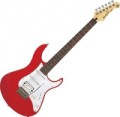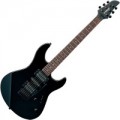Pickup diagram
Electric guitar pickup layout diagram. The letters used in this diagram indicate the types of pickups:
-
S - single. A single-coil pickup that looks like a narrow strip, often with a number of “buttons” (magnets) corresponding to the number of strings. Such modules provide clear and ringing sound, well suited for jazz, blues and other similar genres. On the other hand, the sound saturation from single-coils is not very high; they are poorly compatible with distortion and other similar effects, which is why they are poorly suited for “heavy” styles of music. In addition, such pickups are susceptible to external magnetic fields, which can degrade the sound.
-
H - humbucker. A type of pickup with two coils, originally created to compensate for the shortcomings of single coils - in particular, to reduce the level of interference from external magnetic interference. However, in the end it turned out that humbuckers differ noticeably in the color of the sound: it turns out to be less expressive, but more dense and rich, making it excellent for playing “overload” (distortion, overdrive, etc.). A classic pickup of this type has two coils positioned side by side, making it noticeably wider than a single coil; and Standard class humbuckers generally look like two single coils installed close to each other. However, in addition to this, there are other design options - for example, a hamcanseller
..., which has coils “on two levels” and is comparable in width to a single. Also note that there are humbuckers that can switch to single-coil mode (see “Coil Cutoff” for more details).
—J. A subtype of S-type pickups with one coil and an additional pole for each string. This variety first appeared on the legendary Fender Jazz Bass. J pickups have a versatile sound that suits almost any style of music.
—P. P pickups have two magnetized poles per string, but they have a unique feature: they are cut in half and wound in reverse. The advantage of this winding is the humbucker effect (see type “H”). The wide and long shape of the P pickup provides powerful and punchy sound in genres such as rock, metal, punk, etc.
- P90. A special type of single-spool single with a wider but shorter bobbin. These pickups are installed in the bridge or neck area of the guitar. Their distinctive feature is a characteristic “rock and roll” sound with warm, soft and rich timbres. Instruments with P90 pickups are often used in alternative rock, blues, indie, etc. styles.
The pickup diagram describes their types, number and relative positions. Our catalog uses a bridge-to-neck designation: for example, an HSS design means the guitar has one humbucker at the bridge and two single-coils near the neck.
This parameter determines, first of all, the overall color of the instrument’s sound. Thus, the above version of HSS will produce a sound that is quite clean and expressive, but at the same time a little denser and lower than on a purely “single-coil” electric guitar. There are many models available that are equipped with only one type of pickups. Moreover, the more pickups, the deeper and richer the sound, as a rule. In addition to all this, many other factors affect the sound of the instrument, so when choosing, you should not look only at the pickup circuit.Shape
The general shape of the body of an electric guitar.
The solid body of an electric guitar can be molded into almost any shape; hollow cases do not give such freedom, however, even among them, the options in shape can be very diverse. However, there are certain standard forms. It is not uncommon for these shapes to be named after a particular "legendary" guitar model, such as the "Les Paul" or "Stratocaster" (after Gibson and Fender instruments of the same name, respectively). It makes no sense to describe each standard form — it's easier to find an illustration in our catalog or on the Internet.
The main, and often the only point, which is affected by the shape of the body is the appearance of the guitar. Also, convenience for the musician to some extent depends on this parameter — for example, some models allow you to play while sitting, resting the instrument on your foot, for others this method is weak or not suitable at all. But whether the shape of the body affects the sound of an electric guitar is a moot point. There is an unequivocal dependence only in semi-acoustic models, but for solid bodies there is no clear answer to this question: some musicians claim the superiority of some forms over others, but this moment is largely subjective. In addition, other parameters (types and number of pickups, bridge design, etc.) greatly affect the sound quality.
Now on the market there are guitars with this body shape:
Les Paul,
Superstrat,
Stratocaster,
Jazz Bass,
Precision Bass,
Telecaster,
PRS Santana,
Flying V,
SG, however, there are also completely
non-standard options.
Pickguard
The presence of a protective lining (pickguard) on the body of the guitar.
Such an overlay is located on the upper deck, most often made of durable plastic and differs markedly in colour, due to which it is clearly visible. Its main purpose is to protect the soundboard surface from pick strikes (for example, when playing with dynamic fighting), which could damage the varnished wooden surface. The specific shape and size of the fingerboard may vary, but anyway, it covers at least the surface below the strings (when looking at the guitar in the working position), and sometimes under the strings and even above them.
Material
The material from which the body of an electric guitar is made. For models with cutouts (semi-acoustic, see "Type"), in this case, only the material of the back deck and sides can be taken into account, and data on the top deck is given separately (for more details, see "Deck Cover Material").
Now on the market there are cases of such trees:
red,
maple,
agatis,
ash,
alder.
It makes no sense to dwell on each of the materials found in modern electric guitars. Their variety is very large, however, unlike acoustic guitars, the body in this case does not play such a significant role in shaping the sound, and its material has a relatively small effect on the acoustic properties of the instrument (although the exact degree of such influence is a moot point). If you wish, you can find detailed data on a particular material in special sources, but in fact it makes sense to look primarily at the appearance of the instrument and its price category.
Neck profile
Profile of a fretboard mounted on an electric guitar.
The profile of the neck is called its shape in section, more precisely, the shape of the back of the neck. This parameter practically does not affect the sound of the guitar, but it directly affects the convenience of playing. Ideally, the neck should “fill” the hand, but not be too large — otherwise it will not be possible to clasp it to the right extent.
Profiles are denoted by the letters C, D, V and U — depending on which letter the neck resembles in the section. Profile D is the flattest, C is slightly more convex, with almost uniform curvature along the entire length, U is more voluminous, with a wider profile in the area of the lining, and the V profile in its classic form has the form of an angle with a rounded top. There are also modifications of these options — for example, "thin", which provides for a reduced profile thickness, or "modern", with slightly improved (theoretically) ergonomics.
The most popular profile types are
C,
U and their "modern" (modern) modifications. The C profile is almost semi-circular, the U profile is more voluminous, at the fingerboard its edges are almost parallel and only closer to the back of the neck are sharply rounded. The terms
modern C and
modern U refer to various improved versions of these profiles, their f
...orm may be different.
In fact, the choice of neck profile depends solely on the guitarist's personal preferences, the characteristics of his hands and his preferred playing technique. Thus, there is no "perfect" profile shape — in each case, the optimal choice will be different. The perfect option is to try several types of profile "live", decide which one will be more convenient, and choose an instrument with a neck of the same or similar profile shape.
